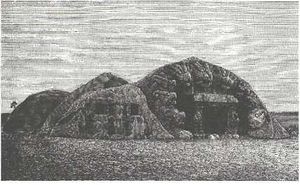Cave Temples
By Swami Harshananda
Artificial caves were excavated for religious purposes from the time of Aśoka. Three phases of development of rock-cut architecture are listed by Indologists:
- The first phase from the 2nd cent. B.C. to the 2nd cent. A.D. - The two caves of Barabar Hill near Gayā in Bihar dedicated by Aśoka to the Ājīvika monks, the cave at Karli and some Buddhist caves at Ajanta (both in Maharashtra), the Jaina caves at Udayagiri and Khaṇḍagiri (Orissa) belong to this phase.
- The second phase from the 5th to the 7th cent. A.D. - Many caves at Ellora (Maharashtra) come under this phase.
- The third phase from the 7th to the 10th cent. A.D. - The Hindu and Jain temples at Ellora, Elephanta and Salsette islands near Mumbai (all in Maharashtra) belong to this phase.
Out of about 1200 rock-cut caves discovered (in India), nearly 900 are Buddhist, 200 are Jaina and the rest Hindu.Out of all the Buddhist caves, those at Ajanta, Ellora, Karli and Nasik (all in Maharashtra) are celebrated. Among the Jain caves, those at Ellora are noteworthy. The rock-cut temples at Ellora, Elephanta and Bādāmi (in Karnataka) are equally famous. The Rathas of Mahābalipuram (Tamil Nadu) and the temple of Kailāśanātha at Ellora, though not cave temples, come under the general group of rock-cut temples and are unrivaled.
All the Buddhist cave temples of the early phase generally have caitya halls and a stupa in them. They are vaulted rectangular halls with an apsidal and contain a stupa. Among them there are also vihāras or Buddhist monasteries with not only living rooms but also a shrine-cell with an image of the Buddha cut out of the rock in the rear wall.
The cave temples generally exhibit the same plan, pattern and elements of architecture which were well developed in later years in the regular temples built above the ground.
References[edit]
- The Concise Encyclopedia of Hinduism, Swami Harshananda, Ram Krishna Math, Bangalore

